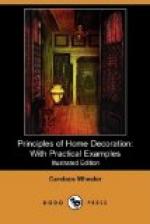Of course there are certain laws of optics and ingenuities of composition which may palliate this effect, but the fact remains that the floor should be covered in a way which will leave the mind tranquil and the eye satisfied, and this is hard to accomplish with what is commonly known as a figured carpet.
If carpet is to be used, it seems, then, that the simplest way is to select a good monochrome in the prevailing tint of the room, but several shades darker. Not an absolutely plain surface, but one broken with some unobtrusive design or pattern in still darker darks and lighter lights than the general tone. In this case we shall have the room harmonious, it is true, but lacking the element which provokes admiration—the enlivening effect of contrast. This may be secured by making the centre or main part of the carpet comparatively small, and using a very wide and important border of contrasting colour—a border so wide as to make itself an important part of the carpet. In large rooms this plan does not entirely obviate the difficulty, as it leaves the central space still too large and impressive to remain unbroken; but the remedy may be found in the use of hearth-rugs or skin-rugs, so placed as to seem necessities of use.
As I have said before, contrast on a broad scale can be secured by choosing carpets of an entirely different tone from the wall, and this is sometimes expedient. For instance, as contrast to a copper-coloured wall, a softly toned green carpet is nearly always successful. This one colour, green, is always safe and satisfactory in a floor-covering, provided the walls are not too strong in tone, and provided that the green in the carpet is not too green. Certain brownish greens possess the quality of being in harmony with every other colour. They are the most peaceable shades in the colour-world—the only ones without positive antipathies. Green in all the paler tones can claim the title of peace-maker among colours, since all the other tints will fight with something else, but never with green of a corresponding or even of a much greater strength. Of course this valuable quality, combined with a natural restfulness of effect, makes it the safest of ordinary floor-coverings.




